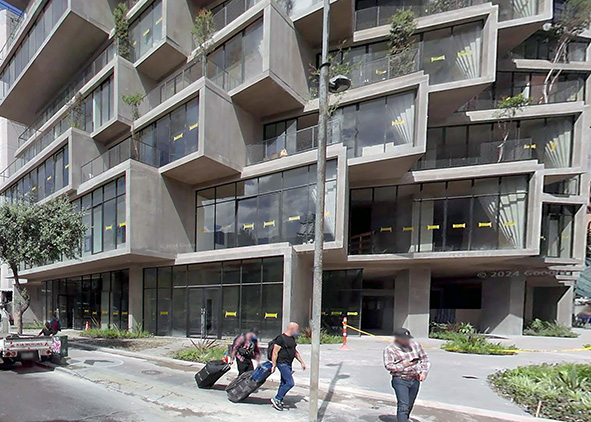Critiquing complexity and contradiction in Architecture
DOI:
https://doi.org/10.19229/2464-9309/1692024Keywords:
architecture, complexity, contradiction, dysfunction, VenturiAbstract
This paper challenges the idea that complex building geometries reflect the complexity of contemporary life; it does so by examining Complexity and Contradiction in Architecture, Robert Venturi’s seminal work from 1966, as well as later writings by advocates of a computationally-driven complexity. The essay shows that: a) complexity, rather than being defined absolutely, is relative in everyday speech; b) complexity, as defined in natural systems, cannot be extrapolated to human behavior; c) modern life is becoming simpler, rather than more complex; d) complexity is typically embedded within products and systems and, as such, inaccessible to ordinary consciousness; e) architectural complexity reflects a competitive drive for notoriety associated with avant-garde production, and leads to energy-inefficient buildings with an increased risk of control layer failure.
Article info
Received: 06/09/2024; Revised: 03/10/2024; Accepted: 04/10/2024
Downloads
Article Metrics Graph
References
Bardi, U. (2020), Before the Collapse – A Guide to the Other Side of Growth, Springer, Cham. [Online] Available at: doi.org/10.1007/978-3-030-29038-2 [Accessed 27 August 2024].
Braverman, H. (1974), Labor and Monopoly Capital – The Degradation of Work in the Twentieth Century, Monthly Review Press, New York. [Online] Available at: jstor.org/stable/j.ctt9qfrkf [Accessed 27 August 2024].
Caws, P. (2015), “General Systems Theory – Its Past and Potential”, in Systems Research and Behavioral Science, vol. 32, issue 5, pp. 514-521. [Online] Available at: doi.org/10.1002/sres.2353 [Accessed 27 August 2024].
Digital History (n.d.), “Housework in Late 19th Century America”, in digitalhistory.uh.edu, Topic ID 93. [Online] Available at: digitalhistory.uh.edu/topic_display.cfm?tcid=93 [Accessed 27 August 2024].
Forty, A. (2004), Words and Buildings – A Vocabulary of Modern Architecture, Thames & Hudson, New York.
Fundación Juan March (ed.) (2014), Josef Albers – Minimal Means, Maximum Effect, Fundación Juan March, Madrid. [Online] Available at: monoskop.org/images/1/10/Josef_Albers_Minimal_Means_Maximum_ Effect_2014.pdf [Accessed 27 August 2024].
Giedion, S. (2009), Space, Time and Architecture – The Growth of a New Tradition, Harvard University Press, Cambridge. [Online] Available at: hup.harvard.edu/books/9780674030473 [Accessed 27 August 2024]
Grant, B. F., Chou, S. P., Saha, T. D., Pickering, R. P., Kerridge, B. T., Ruan, W. J., Huang, B., Jung, J., Zhang, H., Fan, A. and Hasin, D. S. (2017), “Prevalence of 12-Month Alcohol use, high-Risk Drinking, and DSM-IV Alcohol Use Disorder in the United States, 2001-2002 to 2012-2013 – Results from the National Epidemiologic Survey on Alcohol and Related Conditions”, in JAMA Psychiatry, vol. 74, issue 9, pp. 911-923. [Online] Available at: doi.org/10.1001/jamapsychiatry.2017.2161 [Accessed 27 August 2024].
Hawkinson, J. A. (2010), “MIT Settles with Gehry over Stat Ctr. Defects”, in The Tech, vol. 130, issue 14, pp. 1-12. [Online] Available at: thetech.com/issues/130/14/pdf [Accessed 27 August 2024].
Isaacson, W. (2012), “The Real Leadership Lessons of Steve Jobs”, in Harvard Business Review, vol. 90, issue 4, pp. 92-103.
Jencks, C. (1997), The Architecture of the Jumping Universe – A Polemic – How Complexity Science is Changing Architecture and Culture, Academy Editions, London.
Lynn, G. (1999), Animate Form, Princeton Architectural Press, New York.
Marx, K. (1973), Grundrisse, Penguin Books, London. [Online] Available at: marxists.org/archive/marx/works/download/pdf/grundrisse.pdf [Accessed 27 August 2024].
Molella, A. P. (2002), “Review – Science Moderne – Sigfried Giedion’s ‘Space, Time and Architecture and Mechanization Takes Command”, in Technology and Culture, vol. 43, issue 2, pp. 374-389. [Online] Available at: jstor.org/stable/25147909 [Accessed 27 August 2024].
Nevin Hedlund Architects (n.d.), “E. M. Dirksen Federal Building, Courtroom Renovations”, in hedlundarchitects.com, n.d. [Online] Available at: hedlundarchitects.com/em-dirksen-federal-building [Accessed 27 August 2024].
Ochshorn, J. (2021), Building Bad – How Architectural Utility is Constrained by Politics and Damaged by Expression, Lund Humphries, London.
Schumacher, P. (2011), Autopoiesis of Architecture, John Wiley & Sons, Hoboken.
Thoreau, H. D. (1910), Walden, Thomas Crowell & Co., New York.
Venturi, R. (1966), Complexity and Contradiction in Architecture, The Museum of Modern Art, New York.
Vitruvius (1914), Ten Books on Architecture [or. ed. ca. 30-20 BC], Harvard University Press, Cambridge-London.

Downloads
Published
How to Cite
Issue
Section
Categories
License
Copyright (c) 2024 Jonathan Ochshorn

This work is licensed under a Creative Commons Attribution 4.0 International License.
This Journal is published under Creative Commons Attribution Licence 4.0 (CC-BY).
License scheme | Legal code
This License allows anyone to:
Share: copy and redistribute the material in any medium or format.
Adapt: remix, transform, and build upon the material for any purpose, even commercially.
Under the following terms
Attribution: Users must give appropriate credit, provide a link to the license, and indicate if changes were made; users may do so in any reasonable manner, but not in any way that suggests the licensor endorses them or their use.
No additional restrictions: Users may not apply legal terms or technological measures that legally restrict others from doing anything the license permits.
Notices
Users do not have to comply with the license for elements of the material in the public domain or where your use is permitted by an applicable exception or limitation.
No warranties are given. The license may not give users all of the permissions necessary for their intended use. For example, other rights such as publicity, privacy, or moral rights may limit how you use the material.


















































































